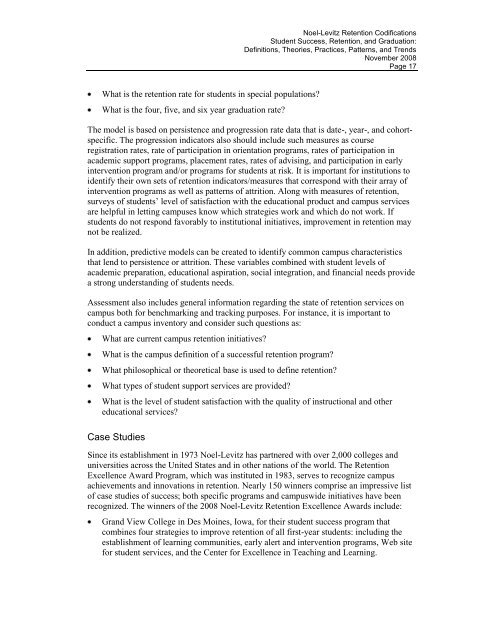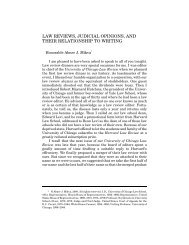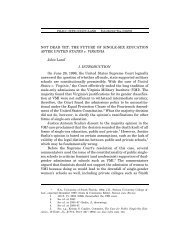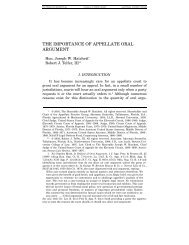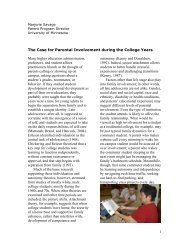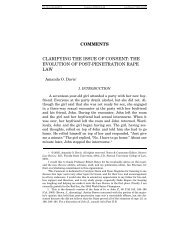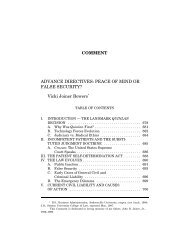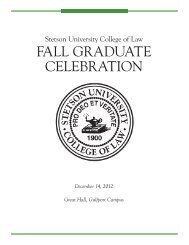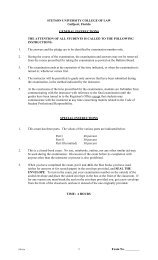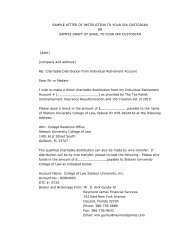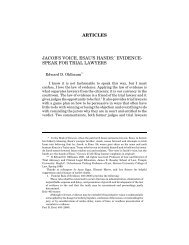Student Success, Retention, and Graduation: Definitions, Theories ...
Student Success, Retention, and Graduation: Definitions, Theories ...
Student Success, Retention, and Graduation: Definitions, Theories ...
Create successful ePaper yourself
Turn your PDF publications into a flip-book with our unique Google optimized e-Paper software.
Noel-Levitz <strong>Retention</strong> Codifications<strong>Student</strong> <strong>Success</strong>, <strong>Retention</strong>, <strong>and</strong> <strong>Graduation</strong>:<strong>Definitions</strong>, <strong>Theories</strong>, Practices, Patterns, <strong>and</strong> TrendsNovember 2008Page 17What is the retention rate for students in special populations?What is the four, five, <strong>and</strong> six year graduation rate?The model is based on persistence <strong>and</strong> progression rate data that is date-, year-, <strong>and</strong> cohortspecific.The progression indicators also should include such measures as courseregistration rates, rate of participation in orientation programs, rates of participation inacademic support programs, placement rates, rates of advising, <strong>and</strong> participation in earlyintervention program <strong>and</strong>/or programs for students at risk. It is important for institutions toidentify their own sets of retention indicators/measures that correspond with their array ofintervention programs as well as patterns of attrition. Along with measures of retention,surveys of students’ level of satisfaction with the educational product <strong>and</strong> campus servicesare helpful in letting campuses know which strategies work <strong>and</strong> which do not work. Ifstudents do not respond favorably to institutional initiatives, improvement in retention maynot be realized.In addition, predictive models can be created to identify common campus characteristicsthat lend to persistence or attrition. These variables combined with student levels ofacademic preparation, educational aspiration, social integration, <strong>and</strong> financial needs providea strong underst<strong>and</strong>ing of students needs.Assessment also includes general information regarding the state of retention services oncampus both for benchmarking <strong>and</strong> tracking purposes. For instance, it is important toconduct a campus inventory <strong>and</strong> consider such questions as:What are current campus retention initiatives?What is the campus definition of a successful retention program?What philosophical or theoretical base is used to define retention?What types of student support services are provided?What is the level of student satisfaction with the quality of instructional <strong>and</strong> othereducational services?Case StudiesSince its establishment in 1973 Noel-Levitz has partnered with over 2,000 colleges <strong>and</strong>universities across the United States <strong>and</strong> in other nations of the world. The <strong>Retention</strong>Excellence Award Program, which was instituted in 1983, serves to recognize campusachievements <strong>and</strong> innovations in retention. Nearly 150 winners comprise an impressive listof case studies of success; both specific programs <strong>and</strong> campuswide initiatives have beenrecognized. The winners of the 2008 Noel-Levitz <strong>Retention</strong> Excellence Awards include:Gr<strong>and</strong> View College in Des Moines, Iowa, for their student success program thatcombines four strategies to improve retention of all first-year students: including theestablishment of learning communities, early alert <strong>and</strong> intervention programs, Web sitefor student services, <strong>and</strong> the Center for Excellence in Teaching <strong>and</strong> Learning.


